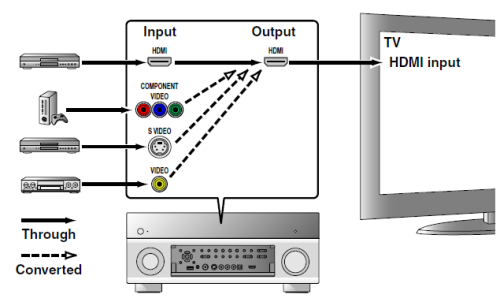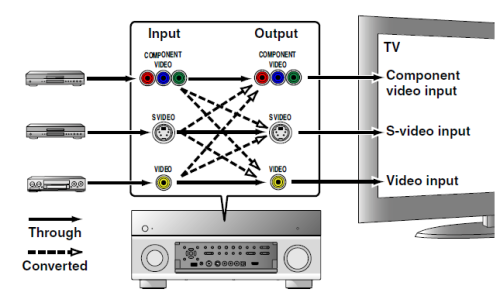Videofeatures
In addition to surround decoding, the various home theater amplifiers numerous picture functions. This section of the guide covers the most common such functions
Video Conversion
Most home theater amplifiers / processors now supports conversion from one type of video signal to another. Typically this conversion of composite, S-video and component signal to HDMI. This makes it possible that one can connect to sources with different types of video signal and then just connect a cable to a TV or projector. The picture below shows how the different analog video signal types all being converted to HDMI signal for a common connection.

Some receivers also offer konveretering other types of analog signals for connection to a TV or projector with only analog connection. Some also have conversion reduces quality such as conversion from component to composite. The picture from a Yamaha manual shows how the amplifier converts signal between the different signal types.

Upscaling
Upscaling video signal means that the amplifier upscales the resolution from a resolution to another. This can eg be to increase from the standard DVD resolution of 720 x 576 pixels to 1920 x 1080. The advantage of this is that the amplifier can potentially do this job better than your TV or projector. In many cases, do not need this feature to provide some positive effect.

Often bildebehandlingskretense used in amplifiers from famous manufacturers like Faroudja, ABT and Qdeo and they are often used as a purchase argument for special amplifiers.
Video Calibration
A few home amplifiers also allows that one can do video calibration on your home amplifier. This can be an advantage if you have a TV or projector with limited calibration opportunities. Some of these in turn are accepted by the ISF that ensures bildekalibreringern can be performed in the best possible way.
AV-Amplifiers
Forum - last updated topics
- God jul og godt nyttår! ( 1) [ Siste ]
- Høytalerplassering til 7.1 Atmos ( 1) [ Siste ]
- er forumet nedlagt? ( 1) [ Siste ]
- er forumet nedlagt? ( 1) [ Siste ]
- NAD T478, ingen lyd på sub i PCM eller stereo ( 1) [ Siste ]
- Høytalere til HK AVR7000 ( 7) [ Siste ]
- Båndbredde på Monster 400 HDMI kabel? ( 7) [ Siste ]
- Prosjektortips? ( 1) [ Siste ]
- Sony vpl-hw40es ønskes kjøpt ( 1) [ Siste ]
- Sony vpl-hw40es ønskes kjøpt ( 1) [ Siste ]
